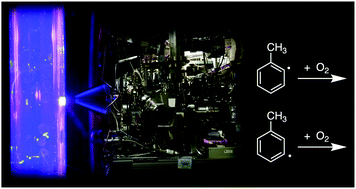Product detection study of the gas-phase oxidation of methylphenyl radicals using synchrotron photoionisation mass spectrometry†
Abstract
Product detection studies of the gas-phase oxidation of o-methylphenyl radicals and m-methylphenyl radicals are reported at ambient temperature (ca. 298 K) and 4 Torr (533.3 Pa) using VUV synchrotron photoionisation mass spectrometry. It is shown that cyclopentadienone (c-C5H4![[double bond, length as m-dash]](https://www.rsc.org/images/entities/char_e001.gif) O) + CH3CO and o-quinone methide (o-CH2
O) + CH3CO and o-quinone methide (o-CH2![[double bond, length as m-dash]](https://www.rsc.org/images/entities/char_e001.gif) C6H4
C6H4![[double bond, length as m-dash]](https://www.rsc.org/images/entities/char_e001.gif) O) + OH are unique product pathways to the o-methylphenyl + O2 reaction due to mechanisms requiring the CH3 group to be adjacent to the phenyl radical site. Common product pathways include methylphenoxy radical + O(3P) and isomers of methylcyclopentadienone (CH3C5H4
O) + OH are unique product pathways to the o-methylphenyl + O2 reaction due to mechanisms requiring the CH3 group to be adjacent to the phenyl radical site. Common product pathways include methylphenoxy radical + O(3P) and isomers of methylcyclopentadienone (CH3C5H4![[double bond, length as m-dash]](https://www.rsc.org/images/entities/char_e001.gif) O) + HCO. G3X-K quantum chemical calculations are deployed to rationalise experimental results for o-methylphenyl and m-methylphenyl radical oxidation. The o-quinone methide formation mechanism from o-methylphenyl + O2 is analogous to the formation of o-benzoquinone from o-hydroxyphenyl + O2 where, after O2 addition, the ortho-substituent in the phenylperoxyl intermediate undergoes a 1,5-H shift and eliminates OH. Other reaction products, including methylcyclopentadienone species and methylphenyoxy radicals, are rationalised by applying known phenyl oxidation mechanisms. Transition state bifurcations are present in both radical systems and have exclusive end products (with different molecular mass). Compared to previous o-hydroxyphenyl and charged-tagged methylphenyl radical oxidation studies, there are significantly more products owing to the activation in this radical system and the competitiveness of rate limiting pathways.
O) + HCO. G3X-K quantum chemical calculations are deployed to rationalise experimental results for o-methylphenyl and m-methylphenyl radical oxidation. The o-quinone methide formation mechanism from o-methylphenyl + O2 is analogous to the formation of o-benzoquinone from o-hydroxyphenyl + O2 where, after O2 addition, the ortho-substituent in the phenylperoxyl intermediate undergoes a 1,5-H shift and eliminates OH. Other reaction products, including methylcyclopentadienone species and methylphenyoxy radicals, are rationalised by applying known phenyl oxidation mechanisms. Transition state bifurcations are present in both radical systems and have exclusive end products (with different molecular mass). Compared to previous o-hydroxyphenyl and charged-tagged methylphenyl radical oxidation studies, there are significantly more products owing to the activation in this radical system and the competitiveness of rate limiting pathways.



 Please wait while we load your content...
Please wait while we load your content...